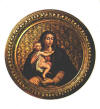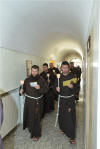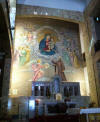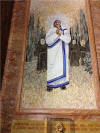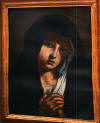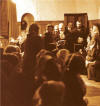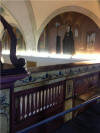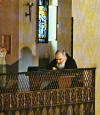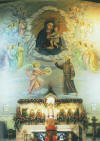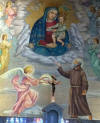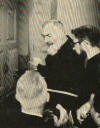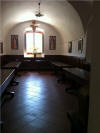21 Routines: 2 cells, 2 churches, 2 confessional, 2 prayer spots
Padre Pio's life in the 52 years he stayed in San Giovanni Rotondo revolved around few yards of space.
Summary: Two cells; two St. Mary of the Graces churches; two confessional; two prayer spots: choir and balcony; two refectories; grooming.
Two Cells
Cell #5






When Padre Pio moved to San Giovanni Rotondo in 1916, he was
assigned the cell #5. The room is very small. On the right side there is a bed,
with a crucifix on the wall, a nightstand, a trunk for
personal things, two chairs, and a case.



 In cell #5 happened the Transverberation.
In cell #5 happened the Transverberation.
Cell #1
Padre Pio moved to this cell in 1943. The cell #1 is roomier than the #5. The armchair with the green cushion is were Padre Pio died. The cell was used by Padre Pio for about thirty years. There are two windows facing south beyond the vegetable garden of the convent. One of the windows has sink replacing the old basin with the pitcher, for washing. From this window Padre Pio used to greet the faithful below, using his handkerchief.
On the side a chest of drawers with several objects on top, and several images on the wall. On the left, a little desk. and a kneeler. Over the bed there are two crucifixes, on the wall near the bed there is a framed Deposition and the intercom box (citofono) to monitor and respond to his needs. At the foot of the bed there is a painting of the Madonna of Purity, in a very fine artistic wooden frame.
Padre Pio usually kept his Capuchin habit in bed. Padre Pio greeted by Fra' Daniele and Padre Carmelo.
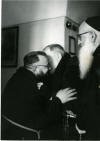


_small.jpg)



 Faithful,
friars, seminarians and bishops outside Padre Pio's cell.
Faithful,
friars, seminarians and bishops outside Padre Pio's cell.
Two St. Mary of the Graces churches
The original church
The original church of St. Mary of the Graces was was built in 1540, destroyed in the earthquake of 1624, redone in 1629, and consecrated to St. Mary of the Graces on July 5, 1676. Padre Pio celebrated Mass in it until 1959. On August 10, 1935 (the 25th anniversary of Padre Pio’s ordination to priesthood), Mons. D’Indico and other florentine friends donated to the convent the lunette majolica that was placed on top of the door to the church of Saint Mary of Graces. The majolica had been commissioned to the the Florentine studio Fratelli Testi.
Padre Pio continued to confess the women in the same confessional since coming to San Giovanni Rotondo in 1916.
The new church of St. Mary of Graces
The new church on the side of the old church and convent. The cornerstone was placed on July 2, 1956. The architect was Giuseppe Gentile from Boiano. Work started on July 2, 1956. The church was consecrated on July 1, 1959. The mosaic behind the altar was made by the Mosaic Studio in Vatican City.
The church has altars and niches for Padre Pio, Pope John Paul II, and mother Theresa. The statue of Madonna delle Grazie is taken into procession every Saturday evening.
Two Sacristies
In the sacristy of the old church Padre Pio got dressed for Mass at the counter. He also passed by the sacristy after confessing the women, and greeted the ones that were waiting.
In the sacristy of the new church, Padre Pio did the thanksgiving after Mass, and then greeted the men waiting. Women were not allowed in the new sacristy.
Two Confessionals
1 Men waiting to confess to Padre Pio, before a system of reservations was implemented. Many days Padre Pio confessed for 19 hours. 2 Lines of women and men before starting reservations in the '50s. 3 The office for reservation of the confession of women. There also was one for men.
Confessions of women
The confessional were Padre Pio confessed the women as it is preserved. The women went to the confessional located on the left side of the original St. Mary's church.
Confessions of men
The men confessed in the old sacristy, behind a courtain. The men kneeled on a kneeler. A confessional box seen for men was temporarily installed in early 1960. Usually the men confessed on the other side of the room.
Two prayer spots: choir and balcony
Choir of the old church
Padre Pio prayed in the original old choir, near the parapet overlooking the church of St. Mary of the Graces. On the arched wall to his right there is the fresco painting of Saint Veronica Giuliani. Veronica had the crown of thorns in 1694, and five the stigmata on her body in 1697.The prayer spot as it has been remodeled

 Padre Pio from his prayer spot could see the nave of the
church below, were people stayed in prayer. When Padre Pio concluded
praying, people below were on the lookout, and stood up, looking in his
direction, to be blessed.
Padre Pio from his prayer spot could see the nave of the
church below, were people stayed in prayer. When Padre Pio concluded
praying, people below were on the lookout, and stood up, looking in his
direction, to be blessed.
Padre Pio in prayer in the center back of the balcony (matroneo in Italian) facing the main altar of the new St. Mary of Graces church, and walking with the friars on the balcony.
Balcony of the new church
1 When Padre Pio was on the balcony he could look at the mosaic of the Madonna. 2 He could also see the nave of the church below, were people were staying in prayer. When Padre Pio concluded praying, people below were on the lookout, and stood up, looking in his direction, to be blessed, as in the old church. 3 When Padre Pio was proclaimed Blessed, his image was added to the mosaic on the altar.
Two Refectories
The original refectory. Padre Pio's place was on the right. It is marked by a sign and a picture of him.
Near the entrance to the refectory of the friars. Padre Pio's intake of food was a remarkable exercise in temperance. He never had breakfast, seldom had dinner, and frequently joined the friars at lunch time. He ate no more then an ounce or two of food, once per day. His favorite food: broccoli rabe (broccoli di rape in italian) (vruoccl e rap in Neapolitan, his native language). He also had at times a sip of beer. Everything was in minuscule quantities, and shared with the other friars. The places were Padre Pio used to sit have now fresh flowers.The last picture shows Padre Pio testing the food of the workers at the hospital, during construction.
Twelve Altars where Padre Pio said Mass
After he was ordained priest, Padre Pio celebrated the first solemn mass in the church of St. Mary of the Angels in Pietrelcina, where the Madonna della Libera is venerated.
He also celebrated mass in the church of St. Anna, the church of his childhood, close to his home.
In the months he spent in Foggia, he said mass in the church of the Capuchin convent.
When Padre Pio was in the military he celebrated Mass in the chapel, when he was allowed.
Main altar of St. Mary of Graces in San Giovanni Rotondo, the original church of the convent, were Padre Pio celebrated mass in special occasions and when the church was full.
In the old church of St. Mary of Graces Padre Pio celebrated mass most frequently at the altar of St. Francis. Here he is giving the final blessing. This was the moment when people on the sides of the altar could see through the wound on Padre Pio's right hand.
In the third picture there is also a woman holding a camera. Many people realized that when they took pictures of Padre Pio the film came out blank.
An altar were Padre Pio used to say Mass was set on a platform outside the old church, in good weather, to accommodate more faithful.
Padre Pio celebrated mass alone in this chapel in the years 1931-1933, when severe restrictions by the Holy Office were implemented.
Another altar was set under the porch of the newly constructed assembly hall. Few years later the hall was demolished to make room for the new St. Mary of the Graces church.Padre Pio used to say mass on this location in good weather, to accommodate the increasing number of the faithful.
Padre Pio celebrates mass at the altar set up at the entrance of "Casa Sollievo della Sofferenza" the day of the grand opening and in other anniversaries.
Padre Pio celebrated Mass and other functions on occasions in the chapel of the hospital "Casa Sollievo"
The altar were Padre Pio celebrated most every day, from 1959 until his death, was at the main altar of the new St. Mary's of the Graces church.












